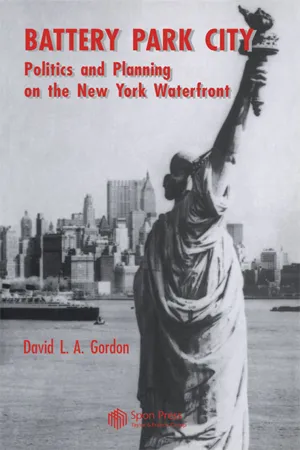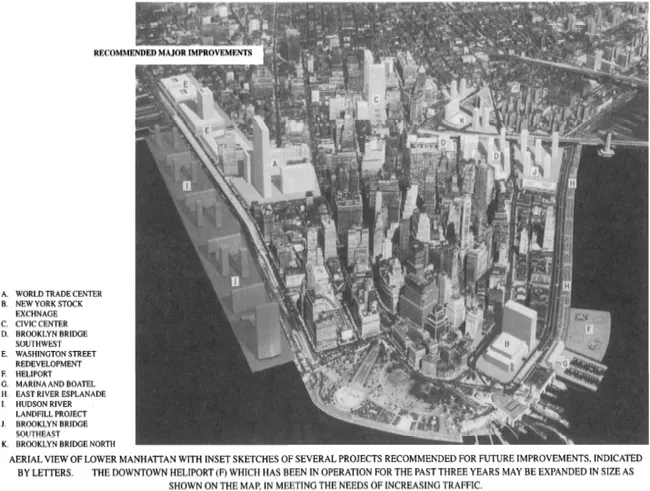![]()
CHAPTER ONE
Duelling Plans: Proposals for the Lower Hudson Waterfront
Once it became obvious that the piers on the lower Hudson River were ripe for redevelopment, there was a scramble to initiate the project. Four separate groups prepared major proposals for its redevelopment from 1963–66:
1. the New York City Department of Marine and Aviation (DMA) which operated the existing piers.
2. the Downtown - Lower Manhattan Association (DLMA) led by David Rockefeller of the Chase Manhattan Bank.
3. the New York City Planning Commission (CPC), which has planning and land use authority.
4. the State of New York, with a personal interest by Governor Nelson Rockefeller.
The New York/New Jersey Port Authority was also active in the area, developing the massive World Trade Center on an adjacent site. It was strongly supported by David Rockefeller and the Downtown-Lower Manhattan Association as they attempted to stem the flow of office development to mid-town Manhattan [Danielson and Doig 1987:318]. The development agenda of each agency can be seen in their land use planning proposals. They used their plans as communications tools in the political debate over control of this high profile site.
Department of Marine and Aviation Plan
Since the City of New York owned the piers and land and regulated urban development, it might be expected that it would control redevelopment of the lower Hudson River waterfront. Indeed, the first major proposal for the site's development was put forward by the New York City Department of Marine and Aviation in April 1963 containing:
● six commercial pier slips
● eight office buildings
● eighteen high-rise apartment buildings with 4500 dwelling units
● a forty story hotel [Home 1963]
The DMA study was led by Ebasco management consultants and designed by Eggers and Higgins architects. The first phase of the plan included landfill from the Battery Park to Chambers Street, with apartments and offices built on top of a continuous 100 acre complex of freight and slipping terminals (Figure 5). Subsequent phases were to include a convention center and a new ‘super-liner’ terminal to handle the substantial increase in maritime passenger traffic expected by the Department at that time.
The City's Department was now in the last stages of its struggle for control of the Manhattan waterfront [NY CPC 1964]. It was broke and wedded to an obsolete freight technology and to a dream of continued high volumes of marine passenger traffic. The ocean liner and general cargo freighter had been supplanted by the jet aircraft and container ship. The Port Authority had scooped them on both counts by building the container port and taking over the region's airports. In addition, the Department's plans for office buildings and industrial uses were opposed by David Rockefeller and the DLMA. The Marine and Aviation Department plan sank, but some parts were later salvaged by the organizations which followed their lead.
The Department tried to hang onto the site again in November 1966, when it proposed a short takeoff and landing airport. This proposal was also ignored. Ironically, the superliner terminal was later completed and now sits almost unused near Midtown Manhattan.
The Downtown-Lower Manhattan Association
The Downtown-Lower Manhattan Association was one of the most powerful and effective private planning organizations in New York during the 1950’s and 1960’s. David Rockefeller founded the organization in 1957, and showed leadership by building a new bank headquarters at Chase Manhattan Plaza during a period when Midtown Manhattan was the dominant location for new development. The DLMA commissioned a plan for the downtown area [DLMA 1958] and proposed that the Port Authority build the World Trade Center.
Figure 5 The New York City Department of Marine and Aviation 1963 Plan (Eggers and Higgins Architects).
Source: City of New York.
The Department of Marine & Aviation proposal appeared while the DLMA was revising its 1958 plan. They liked the idea of landfill along the lower Hudson, but wanted a large residential community adjacent to their office developments, without further commercial competition. Their consultants, Skidmore, Owings and Merrill, quickly changed their plan to include housing and a hotel on the Hudson River and new buildings for the stock exchange and a “world trade center” along the East River [DLMA 1963; Wrubel 1995 interview]. Their plan (Figure 6) was received cautiously by the press and City when it was released in November 1963.
The DLMA's pressure for redevelopment of the area was sufficiently powerful that Mayor Wagner's administration was forced to respond. The City Planning Commission (CPC) engaged a consortium of planning firms in February 1965 to prepare a comprehensive plan for all of lower Manhattan. The team was led by the Philadelphia planning firm Wallace McHarg Roberts Todd with Wittlesey, Conklin and Rossant of New York as urban designers. Their plan was expected to be completed in early 1966, but a municipal election interrupted the process. John Lindsay was elected Mayor in November 1965 on the Republican ticket. The CPC released a draft version of the plan a month later during the last week of the (Democratic) Wagner administration. The final plan was delayed until the spring, while the new mayor reviewed the proposals. In the meantime, the City was scooped by the Governor.
Governor Rockefeller's Proposal - Battery Park City
Nelson Rockefeller was a man with an “edifice complex”, according to Brendan Gill. His first job was to lease the Rockefeller Center and he also worked on the UN Headquarters for his family before he entered politics. As New York State Governor from 1959 through 1973, he built an astounding array of projects - universities, hospitals, housing, office buildings, parks and the Albany Mall. Rockefeller was concerned about middle income housing in 1961 and established a study committee which proposed massive residential developments like Starrett City in Brooklyn and apartment buildings built on piers on the New York waterfront [Bleeker 1981: 114–16].
Figure 6 The Downtown Lower Manhattan Association 1963 Plan (Skidmore, Owings and Merrill).
Source: Downtown Lower Manhattan Association.
The Governor's interest in a residential development on the lower Hudson River waterfront probably emerged from the World Trade Center project. He had embraced the DLMA's proposal for a major office complex to consolidate firms engaged in foreign trade. The Governor directed the Port Authority to pursue it, since he was not pleased that New York had lost most of the container port traffic. The project immediately fell into trouble as New Jersey (the PA's other political master) opposed the East River site and wanted the offices to reinforce its trans-Hudson (PATH) subway. The two governors eventually agreed that the World Trade Center would be built over the PATH terminal on the Hudson River side, so that “New York would do the paperwork and New Jersey would carry the goods” [Lindquist 1995 interview].
The Port Authority's design team proposed that the fill from the mammoth excavation should be dumped into the river beside the site in 1965 (Figure 7). Nelson Rockefeller recognized the opportunity created by the proposed fill and City's delayed response to the DLMA's plan. He was determined to act in secret, since there was little development in downtown Manhattan in 1965 and it had been quite difficult to implement projects after the retirement of Robert Moses. Rockefeller's staff in Albany looked at the policy questions and the Governor retained his favorite architect, Wallace K. Harrison [Douglass; Lindquist 1995 interviews].
Harrison had earned the Governor's trust as a designer over a thirty year period, starting with the re-design of Rockefeller's apartment in 1934. However, his commission was clearly not favouritism, since Harrison would have been considered one of leading architects of his day [Newhouse 1989]. Harrison had previously built Rockefeller family houses, and worked on the design teams for Rockefeller Center, the 1939 World's Fair, and the UN. Nelson Rockefeller and Wallace Harrison were one of the most powerful client-architect relationsh...


